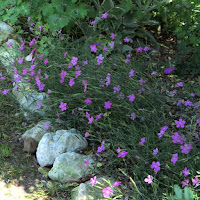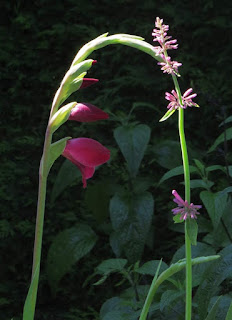"When you realise how perfect everything is, you will
tllt your head back and laugh at the sky."
- Buddha
 |
| Hay bales drying before the next downpour |
After the shock result of the EU Referendum, and the thought of certain right-wing politicians just waiting in the wings for their moment to come, perhaps we all need a bit of Buddha in our lives...?
 |
| Catanache flower with a hungry bee filling its pollen sacs |
Continuing cool and cloudy weather hasn't helped our spirits much either, although flowers do tend to last better when they haven't been subject to prolonged heat.
There's certainly plenty of pollen around but it's hard for insects like butterflies to keep flying when the wind is blowing in strong north-westerly gusts. Having said that, our lavender flowers have attracted even more hummingbird hawkmoths than usual, which is encouraging to see.
 |
| Lavender 'Munstead Dwarf' making a nice foil for the bright orange hyssop, Agastache aurantiaca |
One of the most vibrant colour combinations in our flower beds is provided by purple or blue flowers grown alongside the flaming orange of hyssop or Cosmos sulphurea, which is yet to come.
Agastache aurantiaca was our first introduction to growing hyssops, picked from Chiltern Seeds' collection because they promised it would flower in its first season. They were right - it's an easy one to start off with and the flowers on this plant have been increasing year on year.
Since then, we've grown some of the taller Mexican varieties - like 'Sangria' - which make dramatic additions to our late-Summer border but are not always hardy through winter.
Colour selections
Colour selections
 |
| Achillea "Terracotta' next to Catanache caerulea |
I ordered a mixed selection called 'Summer Pastels' from Chiltern Seeds last year and it's fun to see which colours are emerging now and how they're combining - or not! - with neighbouring plants.
In the case of perennials, you can easily move those which clash once they are dormant again at the end of the year.
So far, we seem to have got some pink, including a pretty salmon colour, plus some white - and there's more to come.
 |
| Palely loitering... |
Over the years we've experimented with different types in varying shades of pink and white: some more spotted than others; some with tubular flowers which point up rather than down... the list is seemingly endless if you're a real foxglove fan!
 |
| Digitalis x mertonensis an RHS choice plant |
This summer we have a new one which is still blooming in the front garden, planted just in front of an escallonia hedge where it's in shade for much of the day.
As you can see from this picture, its main flower spike unfortunately developed at an angle due to the fact that we didn't trim the hedge before it began madly sprouting, cutting off access to the light above.
 |
| Digitalis purpurea annua 'Sutton's Apricot' - another RHS recommendation available from Chiltern Seeds |
neat rosettes of dark green leaves which resisted being chewed or discoloured - although Christina did find they were harbouring a host of snails underneath!
It may have been our damp weather but I didn't like the way its flowers faded, turning brown at the edges before shrivelling.
'Sutton's Apricot', on the other hand, looked lovely right up to the end, as did our original alba's which are delightfully speckled and glow in the late evening.
Perennials in Pots
 |
| Sanguisorba menziesii, blooming merrily in a pot |
Having grown several sanguisorba plantlets from seed, I was disappointed last summer when they produced nothing but a few leaves even though I'd sited them in a cooler, damper part of the back garden where I hoped they might flourish.
I had one plant remaining in it's original pot so we transferred this to a larger terracotta pot, together with a spare nicotiana and some bits of lobelia. The tobacco plant immediately rewarded us by blooming profusely for weeks.
Meanwhile, the sanguisorba had also clumped-up well, displaying pretty leaves even without producing flowers. So we decided to let them all over-winter in the pot and slowly come back to life again in spring.
Now, as you can see, it has sent up tall, strong stems of maroon blooms which catch the evening light beautifully - whilst those plants left in the border have yet to flower!
 |
| Lychnis coronaria alba - under a shady ash tree |
You could call it very accommodating as its seedlings come up in all sorts of inhospitable areas and we tend to treat it as an annual, pulling up the unattractively shrivelled foliage at year-end.
This white variety makes a pleasant change and certainly illuminates our dark corners.
 |
| Penstemon digitalis 'Husker Red' |
In previous posts I've talked about trying to create contrasts for dramatic effect in the garden.
'Husker Red' is a plant which looks handsome even before it bursts into bloom, whereupon its bright white flowers really stand out against the dark stems - an effect intensified by the bronzy-red foliage of a neighbouring physocarpus.
There's so much greenery in our beds by high summer that we have to make a conscious effort to break it up!
 |
| Dianthus deltoides, the original Maiden Pink |
They're a slightly paler magenta than the lychnis I mentioned above and their starry little blooms stand out well from dark green grass-like stems, making them useful edging plants under a shrub or hedgerow where there's only dappled sun for part of the day.
 |
| Gladiolus papilio 'Ruby' with emerging hyssop |
To complement these jewel-like hues, we planted a few bulbs of Gladiolus papilio 'Ruby' - a hardy hybrid from South Africa, which grows to at least a meter tall and has rich red blooms (larger than those of Gladiolus byzantinus).
Soon to come, on the other side of the garden, will be crocosmias of dazzling yellow and orange... at least our borders will be sunny, even if the weather isn't!
 |
| Hedgerow blackberries in bloom - one advantage of a damp summer will be loads of berries and other fruits to come! |
 |
| Blue borders always look best in shade or at dusk |
No comments:
Post a Comment